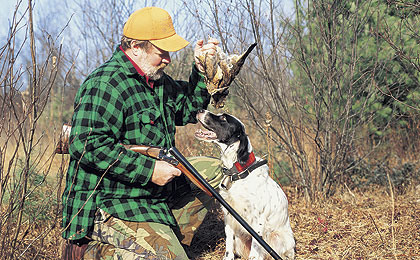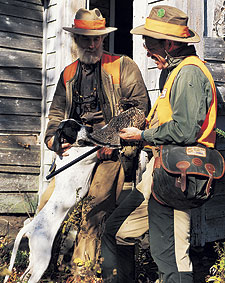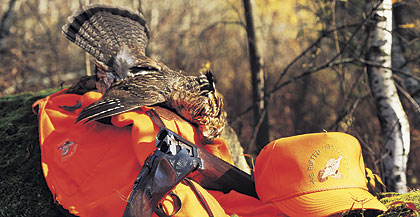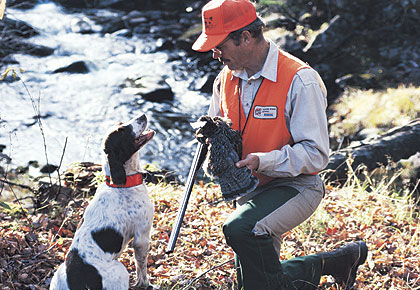The physics of beauty...redefined.
By Joe Arnette
The grouse was no novice, no youngster that luck shoved down the perfect flight path out of harm's way. He--and I was positive it was a male--made the right moves at the right times. Besides, I was sure I knew this bird; I would have bet a truckload of No. 8s it was the same cock grouse (a striking red-phase bird; grays predominate in my part of the Maine woods) that had outfoxed me in the same place and in much the same fashion twice during last year's season.
 English setters are the traditional dogs of the northeastern grouse woods, both in mind's eye and in reality. It's imposible to deny their elegance in the covers and their effectiveness on Yankee pa'tridge. |
The crafty grouse--"pa'tridge" in Maine lingo--had flushed 25 yards in front of me off the backside of a steep hill. My springer, a veteran hunter that knew the cover, had worked the bird's twisting trail into a corner of a weedy farm road from another time and a postage-stamp field. At the field's edge was a splendid red maple whose spread of limbs had once shaded the dooryard of a dwelling.
I was angling toward the maple and the dog's bell, trying to head off the bird and pin him in the corner, when the October breeze freshened and the air went wild with leaves: yellow leaves and crimsons and lighter shades of reds, rusts, and magentas swirled around me. It was a stunning show, and for a moment I was paralyzed by the sight. And that pause was long enough for dog and grouse, both unconcerned with beauty, to converge near the big maple.
 Taking time to admire a grouse brought to bag is a requisite part of the experience. |
The bird exploded from a tangle of undergrowth amidst wing-fanned dust and debris, then arced sharply down and to the side behind the maple to beat toward the safety of an adjacent pine stand. In the instant before he was screened by the tree, the pa'tridge looked blurred, hazy and stretched out a yard long.
The springer had done his job well; he put the grouse in the air and his butt on the ground, where he stayed, leaning muscle-tense and staring along the wake of the departed bird. I, on the other hand, stood off balance with shotgun half-raised and unfired, watching dust from the flush drift away on the wind. My mind had wandered just when the bird jumped and deftly sideslipped behind the maple and into deep cover mapped in his brain.
His turf was a part of a long-abandoned farmstead, a sprawl of hardscrabble acreage where families had scratched meager livings from the rocky earth of Maine. And they had worked at it, as evidenced by overgrown lanes now traveled only by hunters and hunted; antique apple orchards with scattered, arthritic survivors still hanging on; run-amok berry brambles; small, barely discernable clearings. There were rock-lined cellar holes of dwellings collapsed on themselves; tumbledown stone walls marking boundaries and faint two-tracks to nowhere; granite blocks of millraces that once dammed a silvery ribbon of creek.
In superficial ways, this cover resembles those all over New England, while in others it is uniquely Maine. More southerly uplands are softer, the classic New England of calendar art; scratch the surface of the far northcountry and you find all of its rough inner self. And this old farmstead is unalloyed Maine right down to small, sad cemeteries whose weathered gravestones chronicle the history of a rock-strewn land that broke more than the plowshares of those who farmed it. But land that challenges the hardiest of people offers a bonanza to ruffed grouse and woodcock.
Earlier, with the sun up and warming the earth (pa'tridge and timberdoodles don't demand a crack-of-dawn presence), the springer and I had finished a ritual of tailgate sitting and listening to the woods come alive. For an active dog--good springer spaniels define "active"--he tolerates and, perhaps, takes his own measure of enjoyment from tailgating. At the least, he has accepted that that's the way life is when we hunt without partners. But when I toss the cold coffee, he's up and waiting for his bell collar. Then a finger snap, and he's off the truck and ready to hunt.
 By any measure, ruffed grouse are the quintessential bird of New Endland cover. Without grouse, "the whole thing is dead." |
After a couple of casts into roadside cover, mainly for the dog to leg-lift and get his head straight, we worked through a sun-dappled aspen stand where grouse often soak up morning warmth and gobble autumnal fare offered by the light ground cover. I heard a grouse flush wild well in front at the same time the springer's windmilling tail signaled game, woodcock judging from his erratic, nose-to-the-ground trail.
Sure enough, up went a bird with the dog nearly lifting it into the air. The woodcock leveled off, then dipped down the aspen slope to an alder run and creek edging the cover near the red maple, where shortly I would bungle my crack at the red-phase grouse before the dog and I dropped into the alders.
The springer flushed six more woodcock and I took one (my self-imposed limit), a bird that led the dog on a long chase and whose evasive repertoire included short-hopping flights and long scoots--yes, woodcock do run--over the damp earth of the creek banks. The dog stayed on the bird until the end, until the twittering flush that was high and swift, corkscrewing back on itself before straightening and heading out above the alders. To top off his bird work, my springer made a nice retrieve--he had no more than a glimpse of the woodcock's forward tumble.
Less than 30 minutes later, as the dog and I took a break, several stringers of Canada geese passed overhead, low and talking plaintively to themselves. The springer glanced at them, then flopped in a clump of cool ferns while I admired the brace of grouse I had just knocked down several hundred yards from the creek.
They were young-of-the-year, two of eight birds clustered together--not uncommon in October--drawn by the bounty of lingering berries. The birds were on the slopes of a shallow ravine gouged by one of the trickles that fed the alder run's creek. I had hunted up the ravine hoping the dog would move a few more woodcock, for no other reason than I liked to watch him work the birds. Then he started making game with on-fire action that screamed g
rouse.
One bird had jumped wild on the ravine's far lip, when the springer went into high gear and flushed the first of my brace, going airborne himself and snapping at tail feathers. I marked that bird's fall and released the dog from his sit just as two more went out to the side. I took a flustered poke at them but reloaded in time to focus on the other half of my pair that the springer shoved skyward. Three more flushed at my shot, then the slopes were quiet. Feathers floated with the breeze as the springer fetched both grouse.
As I sat in the ravine looking at the morning's birds and absentmindedly pulling a burr from my dog's ear, I found myself thinking that as much as I love the style of hard-charging springers--I felt disloyal admitting this--woodcock and young, inexperienced grouse that hold for a close-working flusher are, in fact, perfectly designed for a pointing dog.
 Flushing dogs, like irrepressible springer spaniels, have long been acknowledged for doing yeoman's duty on ruffed grouse and woodcock. Add top retrieving skills to their bird-finding abilities and you have all-round gun dogs at home in the coverts. |
Earlier in the week, a couple of friends and I had hunted another piece of this broad cover with a pointer and English setter--both fine dogs. Although they didn't locate a great many more birds than my springer, a day with them reaffirmed that there is an indefinable yet undeniable magic in a well-stacked point, a standard of elegance that can't be matched by even the most dramatic of flushes. Such elegance is part and parcel of why classic sporting art depicting ruffed grouse and woodcock hunting traditionally features pointers and setters, and why the favored locales for this art have long been the uplands of New England.
I've hunted grouse in a good many places the birds call home, from back forties to wilderness, and Canadian Maritime Provinces to the Rocky Mountains. But there is a mystique about pa'tridge coverts in the northeastern thumb of the U.S. If autumn arrives in all of its splendor, holding nothing back and fully showcasing itself, the season is quintessential New England; it is the one brief period when even nature sheds the mantle of Yankee restraint and gives way to joyful ostentation.
The land transforms itself into a kaleidoscopic exuberance of color in broad swaths and violent splashes made more spectacular against a background of evergreens. Dawns begin cold, with frost tinting the earth and steam rising from the leaf-littered waterways, then soften to days crisp but warming beneath unblemished skies. Breezes bear dry, tangy fragrances unique to mid-autumn, hints of woodsmoke, and in some coastal covers suggestions of tidepool funk.
Autumn in New England--for me, that means Maine--offers a package. Other regions have grouse and woodcock hunting that's as good or better, fall landscapes that are striking in their own right, and blocks of huntable land whose size is on par with a few diminutive New England states. But nowhere do the upland intricacies blend with quite the same artistic perfection as they do on days in the far northeast.
But not just any day will do.
Give me a chill morning when I can stalk the earth of a gone-wild heartbreak of a farm with its tree colors peaked and its creeks, stone walls, and tracks in place. Give me a veteran dog to follow and a red maple and, most of all, a savvy pa'tridge to reassure me that the very essence of the northwoods is alive and thriving. Give me the complete package. Give me the physics of beauty as only an autumn day in a New England cover can unveil it.






